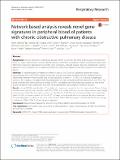Network-based analysis reveals novel gene signatures in peripheral blood of patients with chronic obstructive pulmonary disease

View/
Author
Obeidat, Ma’en
Nie, Yunlong
Chen, Virginia
Shannon, Casey P.
Andiappan, Anand Kumar
Lee, Bernett
Rotzschke, Olaf
Fishbane, Nick
Ng, Raymond T.
McManus, Bruce
Miller, Bruce E.
Rennard, Stephen
Paré, Peter D.
Sin, Don D.
Note: Order does not necessarily reflect citation order of authors.
Published Version
https://doi.org/10.1186/s12931-017-0558-1Metadata
Show full item recordCitation
Obeidat, M., Y. Nie, V. Chen, C. P. Shannon, A. K. Andiappan, B. Lee, O. Rotzschke, et al. 2017. “Network-based analysis reveals novel gene signatures in peripheral blood of patients with chronic obstructive pulmonary disease.” Respiratory Research 18 (1): 72. doi:10.1186/s12931-017-0558-1. http://dx.doi.org/10.1186/s12931-017-0558-1.Abstract
Background: Chronic obstructive pulmonary disease (COPD) is currently the third leading cause of death and there is a huge unmet clinical need to identify disease biomarkers in peripheral blood. Compared to gene level differential expression approaches to identify gene signatures, network analyses provide a biologically intuitive approach which leverages the co-expression patterns in the transcriptome to identify modules of co-expressed genes. Methods: A weighted gene co-expression network analysis (WGCNA) was applied to peripheral blood transcriptome from 238 COPD subjects to discover co-expressed gene modules. We then determined the relationship between these modules and forced expiratory volume in 1 s (FEV1). In a second, independent cohort of 381 subjects, we determined the preservation of these modules and their relationship with FEV1. For those modules that were significantly related to FEV1, we determined the biological processes as well as the blood cell-specific gene expression that were over-represented using additional external datasets. Results: Using WGCNA, we identified 17 modules of co-expressed genes in the discovery cohort. Three of these modules were significantly correlated with FEV1 (FDR < 0.1). In the replication cohort, these modules were highly preserved and their FEV1 associations were reproducible (P < 0.05). Two of the three modules were negatively related to FEV1 and were enriched in IL8 and IL10 pathways and correlated with neutrophil-specific gene expression. The positively related module, on the other hand, was enriched in DNA transcription and translation and was strongly correlated to CD4+, CD8+ T cell-specific gene expression. Conclusions: Network based approaches are promising tools to identify potential biomarkers for COPD. Trial registration The ECLIPSE study was funded by GlaxoSmithKline, under ClinicalTrials.gov identifier NCT00292552 and GSK No. SCO104960 Electronic supplementary material The online version of this article (doi:10.1186/s12931-017-0558-1) contains supplementary material, which is available to authorized users.Other Sources
http://www.ncbi.nlm.nih.gov/pmc/articles/PMC5404332/pdf/Terms of Use
This article is made available under the terms and conditions applicable to Other Posted Material, as set forth at http://nrs.harvard.edu/urn-3:HUL.InstRepos:dash.current.terms-of-use#LAACitable link to this page
http://nrs.harvard.edu/urn-3:HUL.InstRepos:32630439
Collections
- HMS Scholarly Articles [17922]
Contact administrator regarding this item (to report mistakes or request changes)


